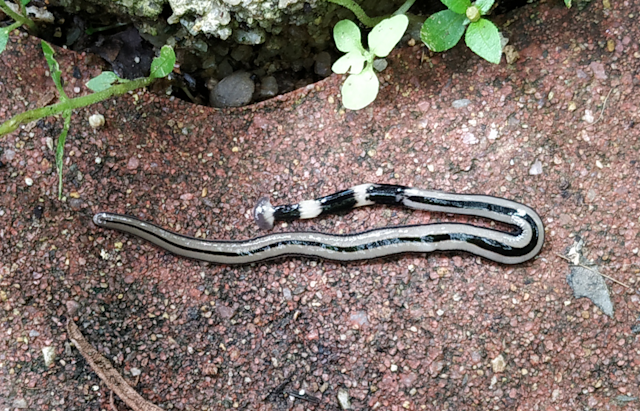George Verdon had a biological enigma on his hands. He’d stumbled across an animal while out for a run which was proving difficult to identify… In all fairness, this run had been through an island jungle on the Malay peninsula, so the chance of finding something weird was significantly higher than usual, but nevertheless this particular animal was resisting his attempts to work out what it was.
It was about 10 cm long and looked like a worm. It also had stark stripey warning colours and for a moment almost looked like a tiny juvenile snake. However, when looking at the head – hammerheaded and flattened and apparently eyeless – it was clearly something different.
As a professional wildlife filmmaker, George has seen a lot of strange animals, but was lost with this one. After some Internet research, he found that there were some scientists crazy enough (us…) to study these weird creatures.
For the last 10 years, we have undertaken to characterise the land flatworms which invade European countries, such as Obama nungara, now found in more than 70 departments in France, or the giant species Bipalium kewense. George got in touch in August of 2019, sending us an e-mail with some photos and asking if we knew any more about it.
Upon comparison with the scientific literature, it turned out to be a species that hadn’t been seen in the 90 years since it was first discovered: Bipalium admarginatum. It hadn’t been recorded since it was first described in 1933 by de Beauchamp, on an island not far away from George’s sighting. Naturally, we were excited, and asked George if he had collected the specimen he had seen. For some reason we don’t understand, he had been out for a jog without a field kit, and had subsequently let the animal glide back into the leaf litter. We asked him if he could dive back into the jungle to find a few specimens, and gave instructions on how best to find and catch them.
Macaques, and quadruple gin and tonic… without tonic
Returning to the scene of the sighting armed with collecting vials, larval forceps, and the help of Liv Grant (a friend and colleague), George found more of the species. This was only half of the challenge, as they turned out to be in the territory of macaques, who were not feeling hospitable. Liv took up the task of fending off the marauders while George hastily collected, and the two quickly retreated.
So far so good, but how to preserve them? The instructions we gave were to put the animals in pure ethanol, but tropical islands are notoriously lacking when it comes to laboratory supplies. Or so we thought… George found a solution: a quadruple gin and tonic, minus the tonic, the lime, the ice, and the umbrella. After putting the specimens into a vial with the gin, George brought them to Michelle Soo, at the UCSI University of Kuala Lumpur, who took charge of verifying the discovery.
Complete mitochondrial genome
The next step was to attempt a molecular analysis of the animal. This is important for characterising it and understanding its relationship with other species of the genus Bipalium. Normally this is only done on specimens well preserved in absolute ethanol. Romain Gastineau, at the University of Szczecin in Poland, tried anyway… and thanks to next-generation sequencing techniques, we were able to characterise the complete mitochondrial genome of Bipalium admarginatum, despite the original harvest in the gin.
Only about 10 complete mitogenomes are known in this family, all the others having been obtained from specimens harvested under perfect conditions and impeccable ethanol in a laboratory. It deserved a publication, which we undertook. We were even able to convince the scientific journal to add a summary in the Malay language, in order to convince the country’s citizens to collect any bizarre worms they will encounter. Hopefully we will receive other specimens, there are so many extraordinary species to discover and rediscover.


